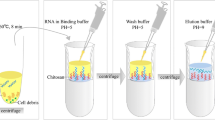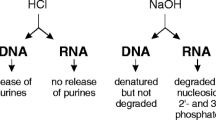Abstract
Extraction of intact RNA is essential for quantitative gene expression analysis. Isolating high quality RNA from gram-positive bacteria is known to be problematic particularly from organisms that have optimal growth temperatures greater than 45 °C. We report a novel extraction protocol for the rapid isolation of fully intact RNA from thermophilic Geobacillus thermoleovorans using a lysing matrix containing a mixture of ceramic and glass beads, triisopropylnaphthalene sulfonic acid (TNS), and p-4-aminosalicyclic acid (PAS). Combining both detergents, TNS and PAS, appeared to increase denaturation of RNases at thermophilic temperatures. Gel electrophoresis revealed that only RNA isolated using the TNS-PAS procedure demonstrated sharp, undegraded 23S, 16S, and 5S ribosomal RNA bands. RNA extracted from geobacilli using commercially available kits was extensively degraded and was not suitable for detecting gene expression. Total RNA yields extracted with the TNS-PAS protocol were greater than eightfold higher than those obtained with available kits. Critically, it was also shown that only RNA isolated with the TNS-PAS-based method was suitable for monitoring thermophile gene expression patterns using RT-PCR analysis.



Similar content being viewed by others
References
Arraiano CM (1993) Post-transcriptional control of gene expression: bacterial mRNA degradation. World J Microbiol Biotechnol 9:421–432
Belasco JG, Higgins CF (1988) Mechanisms of mRNA decay in bacteria: a perspective. Gene 72:15–23
Brown JW, Haas ES, Pace NR (1993) Characterisation of ribonuclease P RNAs from thermophilic bacteria. Nucleic Acids Res 21:671–679
Jones LJ, Yue ST, Cheung CY, Singer VL (1998) RNA quantitation by fluorescence-based solution assay: RiboGreen reagent characterisation. Anal Biochem 265:368–374
Malcolm ADB (1981) Thermophiles and RNA stability. J Theor Biol 92:479–481
Marchant R, Banat IM, Rahman TJ, Berzano M (2002) The frequency and characteristics of highly thermophilic bacteria in cool soil environments. Environ Microbiol 4:595–602
Margesin R, Schinner F (2001) Biodegradation and bioremediation of hydrocarbons in extreme environments. Appl Microbiol Biotechnol 56:650–663
McGrath S, Dooley JSG, Haylock RW (2000) Quantification of Clostridium botulinum toxin gene expression by competitive reverse transcription–PCR. Appl Environ Microbiol 66:1423–1428
Stenesh J, Madison JB (1979) Stability of bacterial messenger RNA in mesophiles and thermophiles. Biochim Biophys Acta 565:154–160
Witholt B, de Smet M-J, Kingma J, van Beilen JB, Kok M, Lageveen RG, Eggink G (1990) Bioconversions of aliphatic compounds by Pseudomonas oleovorans in multiphase bioreactors: background and economical potential. Trends Biotechnol 8:46–52
Zhong X, Luo J, Stevens E Jr (1997) Isolation of full length RNA from a thermophilic Cyanobacterium. Biotechniques 23:904–910
Acknowledgments
This work was supported by a grant, number F/00430/A, from the Leverhulme Trust.
Author information
Authors and Affiliations
Corresponding author
Additional information
Communicated by G. Antranikian
Rights and permissions
About this article
Cite this article
Sharkey, F.H., Banat, I.M. & Marchant, R. A rapid and effective method of extracting fully intact RNA from thermophilic geobacilli that is suitable for gene expression analysis. Extremophiles 8, 73–77 (2004). https://doi.org/10.1007/s00792-003-0363-2
Received:
Accepted:
Published:
Issue Date:
DOI: https://doi.org/10.1007/s00792-003-0363-2




